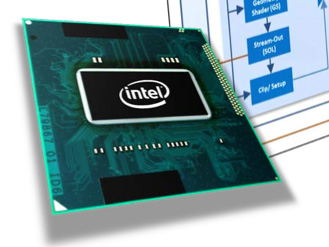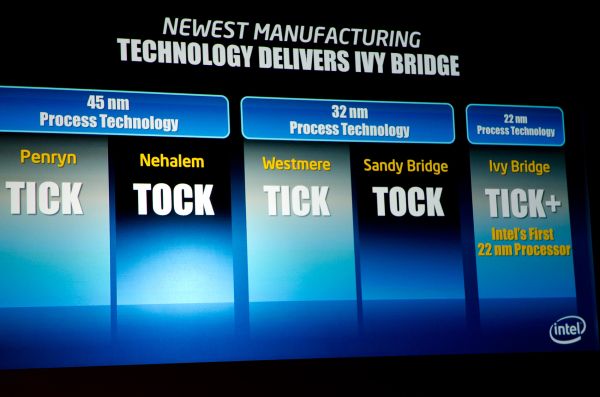The Ivy Bridge Preview: Core i7 3770K Tested
by Anand Lal Shimpi on March 6, 2012 8:16 PM EST- Posted in
- CPUs
- Intel
- Core i7
- Ivy Bridge
Note: This preview was not sanctioned or supported by Intel in any way.
I still remember hearing about Intel's tick-tock cadence and not having much faith that the company could pull it off. Granted Intel hasn't given us a new chip every 12 months on the dot, but more or less there's something new every year. Every year we either get a new architecture on an established process node (tock), or a derivative architecture on a new process node (tick). The table below summarizes what we've seen since Intel adopted the strategy:
| Intel's Tick-Tock Cadence | |||||
| Microarchitecture | Process Node | Tick or Tock | Release Year | ||
| Conroe/Merom | 65nm | Tock | 2006 | ||
| Penryn | 45nm | Tick | 2007 | ||
| Nehalem | 45nm | Tock | 2008 | ||
| Westmere | 32nm | Tick | 2010 | ||
| Sandy Bridge | 32nm | Tock | 2011 | ||
| Ivy Bridge | 22nm | Tick | 2012 | ||
| Haswell | 22nm | Tock | 2013 | ||
Last year was a big one. Sandy Bridge brought a Conroe-like increase in performance across the board thanks to a massive re-plumbing of Intel's out-of-order execution engine and other significant changes to the microarchitecture. If you remember Conroe (the first Core 2 architecture), what followed it was a relatively mild upgrade called Penryn that gave you a little bit in the way of performance and dropped power consumption at the same time.

Ivy Bridge, the tick that follows Sandy Bridge, would typically be just that: a mild upgrade that inched performance ahead while dropping power consumption. Intel's microprocessor ticks are usually very conservative on the architecture side, which limits the performance improvement. Being less risky on the architecture allows Intel to focus more on working out the kinks in its next process node, in turn delivering some amount of tangible power reduction.
Where Ivy Bridge shakes things up is on the graphics side. For years Intel has been able to ship substandard graphics in its chipsets based on the principle that only gamers needed real GPUs and Windows ran just fine on integrated graphics. Over the past decade that philosophy required adjustment. First it was HD video decode acceleration, then GPU accelerated user interfaces and, more recently, GPU computing applications. Intel eventually committed to taking GPU performance (and driver quality) seriously, setting out on a path to significantly improve its GPUs.
As Ivy is a tick in Intel's cadence, we shouldn't see much of a performance improvement. On the CPU side that's mostly true. You can expect a 5 - 15% increase in performance for the same price as a Sandy Bridge CPU today. A continued desire to be aggressive on the GPU front however puts Intel in a tough spot. Moving to a new manufacturing process, especially one as dramatically different as Intel's 22nm 3D tri-gate node isn't easy. Any additional complexity outside of the new process simply puts schedule at risk. That being said, its GPUs continue to lag significantly behind AMD and more importantly, they still aren't fast enough by customer standards.
Apple has been pushing Intel for faster graphics for years, having no issues with including discrete GPUs across its lineup or even prioritizing GPU over CPU upgrades. Intel's exclusivity agreement with Apple expired around Nehalem, meaning every design win can easily be lost if the fit isn't right.
With Haswell, Intel will finally deliver what Apple and other customers have been asking for on the GPU front. Until then Intel had to do something to move performance forward. A simple tick wouldn't cut it.

Intel calls Ivy Bridge a tick+. While CPU performance steps forward, GPU performance sees a more significant improvement - in the 20 - 50% range. The magnitude of improvement on the GPU side is more consistent with what you'd expect from a tock. The combination of a CPU tick and a GPU tock is how Intel arrives at the tick+ naming. I'm personally curious to see how this unfolds going forward. Will GPU and CPUs go through alternating tocks or will Intel try to synchronize them? Do we see innovation on one side slow down as the other increases? Does tick-tock remain on a two year cadence now that there are two fairly different architectures that need updating? These are questions I don't know that we'll see answers to until after Haswell. For now, let's focus on Ivy Bridge.










195 Comments
View All Comments
Articuno - Tuesday, March 6, 2012 - link
Except the quality is the same as competing AMD products if not worse because of driver issues, but you lose 20-30% performance in every scenario versus the last gen Llano APU. The facts are in this very review.Articuno - Tuesday, March 6, 2012 - link
Sure sounds like Bulldozer at this point, doesn't it?""It's just a driver issue, AMD/Intel will fix it!"
"It's just the review units sent out, AMD/Intel will have a BIOS update at the official release that improves performance!"
"If you overclock it to hell and back, it can almost sort of maybe compete with Intel/AMD!"
"Oh look, there's a new update out that improves performance! Sure it's only 1% performance, applicable in only certain scenarios, but it's better than nothing!"
Articuno - Tuesday, March 6, 2012 - link
Aside from that NOT being what I said at all... you do realize you justified the reasoning in your post, right? They're bribing Intel. That doesn't mean they did nothing wrong, it's a BRIBE. Besides, Intel is just as guilty as Microsoft of OEM threatening and hand-holding in the 90s.Makaveli - Tuesday, March 6, 2012 - link
Who the hell is this Sans2212 troll.Dude please do all of us a favour on this site and STFU.
90% of the people reading this site know more than you.
Take your bad english GTFO.
+1 for ban!
Articuno - Tuesday, March 6, 2012 - link
If you Google his handle you'll find out he's been doing this for a while now (and that he's probably Japanese, which would explain the poor English).+2 for ban.
m.amitava - Tuesday, March 6, 2012 - link
I don't think he's serious....reading come of his comments...nobody with a human brain can reason like that...If he IS serious, opens up the possbility of creating an online zoo exhibit out of him...prod him with an AMD logo and he'll roar, shout, roll and snap :)
tipoo - Wednesday, March 7, 2012 - link
Poes law in full swing. The morons are indistinguishable from the people trying to look like them.silverblue - Wednesday, March 7, 2012 - link
Awww I missed it... I usually like reading his rants, especially his obsession with "amd craps". He filled the void SiliconDoc vacated.Jamahl - Tuesday, March 6, 2012 - link
Wake me up when intel does something interesting again.MJG79 - Tuesday, March 6, 2012 - link
2009 - $35B in revenue2010 - $44B (1st $40B year)
2011 - $54B (1st $50B year)
$20B revenue growth in 2 years
You wake me up when there is competition again.